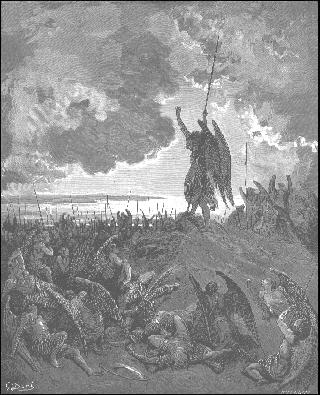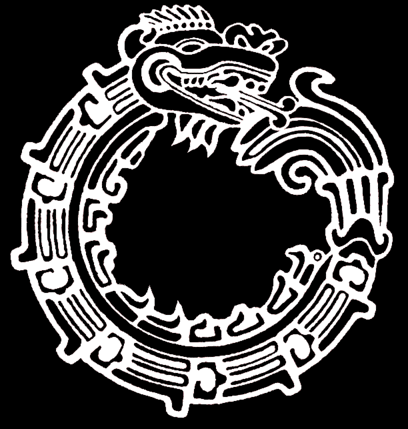
transtopian Symbolism
Ouroboros
The Ouroboros (pronounced as Or-O-bOr-Os) is a snake, worm ('wyrm'),
serpent, or dragon biting its own tail and/or devouring itself. Indeed, the
name roughly translates as "devouring its tail" or "tail
devourer". Alternate spellings include: oroborus, uroboros, and
oureboros. [1] Ouroboros is associated with Alchemy, Gnosticism, and the ancient Greeks (who gave it its current
name), though it appears in many other contexts and cultures as well. It is one of the
archetypal symbols, and may be as old as human civilization itself. It symbolizes
many things -- time, the continuity of life, immortality, infinity, eternity,
perfection, completion, the cyclic nature of the universe, the self-sufficiency
of nature, and the rebirth of the earth, to name but a few. The Ouroboros
is the Universal Serpent which passes through all things -- "the One,
the All." [2]
Jung described the Ouroboros as the "dragon that devours, fertilizes, begets,
slays, and brings itself to life again. Being hermaphroditic, it is compounded
of opposites and is at the same time their uniting symbol" (Ibid., p. 372).
[3]
There are two primary types of Ouroboros: one which merely holds the tip
of its tail between its jaws, and one which swallows it(self). The former
is static. It describes a circle, and partakes of the symbolic meaning of
the circle, which is perfect, eternal, and divides the universe into inside
and outside. It is a magic barrier or circle of protection, and represents
eternal life and perfection. The Ouroboros that swallows its tail is dynamic.
It describes a spiral force, and partakes of the symbolic meaning of the
spiral, which is cyclical, moving, changing, evolving. If we follow mentally
the consequences of a serpent swallowing its tail, we see that in a magical
sense it will reduce itself to a single point and vanish from the universe
utterly. Hence the Ouroboros swallowing its tail represents the gateway between
our universe and the absolute, or to put it more poetically, the Eye of God.
[3]
The primary (Type I) transtopian Ouroboros is of the latter,
self-devouring kind. It represents a philosophy that is dynamic, evolving,
and which will hopefully lead to a higher level of existence, perhaps even
a state of eternal perfection (the domain of God, so to speak). Of course,
if things go wrong we could also end up being erased from the universe, and
vanish into the dark void of nothingness forever. Thus, the self-devouring
Ouroboros represents our two most likely, diametrically opposed destinies.
The 'static', tail-biting (Type II) Ouroboros is the symbolic guardian
of the preserved dead. For those in biostasis, the struggle is (temporarily) over. Like a magic circle, the cryogenic container they rest in shields them from the relentless onslaught of entropy. It is an island in the river of time. If and when the frozen will awaken, it will be into a state of perfection -- at least compared to the world they knew.
Biohazard

|
Originally an American sign, now international, that warns against biologically
dangerous substances. Also associated with danger and death in general.
Ourohazard
Combined, the Biohazard and the Ouroboros symbolize the fact that those who
want to achieve true immortality and godhood must sooner or later transcend their
doomed biological shells, and become inorganic beings. Flesh is simply too
fragile and limited for our purposes. In this context, the Biohazard symbolizes
the difficult but necessary 'shedding of the flesh', and the Ouroboros the
potentially infinite existence, knowledge, and power that will be our reward.
The Ourohazard as portal to transtopia, our future
technological paradise.
The Ourohazard is also a warning, however; apart from being a path
towards ascension, the technological Singularity could also be the end of the road for
us, both as individuals and as a species. The ominous shape of the
Biohazard, symbol of death and danger, looms large behind the Ouroboros, symbol of eternal life. Alternatively, one could say that combining the self-devouring, self-annihilating Ouroboros with the dreaded Biohazard has a strong synergistic effect, which makes the Ourohazard
a somewhat cynical, nihilistic symbol. A harbinger of impending
doom and the final triumph of chaos, entropy, and death. In this respect
it is comparable to the symbolism of the skull. This is the dark side
of Transhumanism; the Ourohazard as gateway to hell and oblivion.
The Ourohazard, with its inherent dualism, is the Singularity incarnate.
The biomechanical Ourohazard also represents the hybrid nature of transtopianism. Just like the philosophy itself, it is made up out of seemingly unrelated or even contradictory elements, which, when put together, suddenly form a unique and logical whole that is greater than
the sum of its parts. The pieces of the puzzle fall into place, and reveal the big(ger) picture.
Last but certainly not least, the Ourohazard is the fierce symbol of supreme
self-liberation and enlightenment. Those who display it essentially say
"Fuck you and the horse you rode in on!" to deathists, religious fanatics,
bourgeois conformists, Luddites, conservatives, PC leftists, and all those other enemies of freedom, reason, and progress. From Truth to Transcendence -- one symbol says it all.
Fleur-de-Lys
The Fleur-de-Lys, which is French for 'Flower of the Lily', depicts a stylized
lily or lotus flower (or, alternatively, an
iris).
The Fleur-de-lys is thought by many authorities to be a conventionalized
form of the Annunciation Lily, symbolizing the Annunciation of the Savior.
Due to its three 'petals', the Fleur-de-Lys has also been used to represent
the Holy Trinity. In a secular sense, the symbol is linked to nobility in
general, and French nobility in particular. Also, due to its aggressive spearhead
/ dagger-like shape, it is sometimes used by, and associated with, the military.
Finally, the Fleur is said to signify perfection, light, and life.
[4]
Wyrm-de-Lys
The Wyrm-de-Lys, a composition of 3 Fleurs overlaid by an Ouroboros, represents the aristocratic side of transtopianism. It symbolizes the fact that this a thinking man's ideology, neither meant for nor appreciated by the ignorant, conformist masses. Those who understand and live according to the Principles are the world's true 'nobility', and worthy of godhood.
Tomoye
The Tomoye is a symbol from the Japanese Samurai heraldry and the ancient
Japanese Shinto religion. The name translates into 'revolution of the universe'. The Tomoye somewhat resembles a stylized Triskelion, a Greek sign that's associated with progress and competition, and this Celtic symbol, which is associated with migrations (to the stars!) and independent movements.
Tomoyeserpent
The Tomoyeserpent, a fusion of the Ouroboros and the Tomoye, represents
the radical nature of transtopianism. This is a philosophia militans; a fighting philosophy. We are the tip of the sword, the shocktroops of the Singularity. The revolution of the universe begins with a revolution of the mind.
-
transtopia
Trans: 1.Across; on the other side; beyond (2.Through. 3.Change; transfer
). Topia: from the Greek word 'topos', meaning 'place'.
[6] Hence, transtopia is the 'place
beyond' (or 'beyondplace'). Beyond the tyranny of entropy; beyond the dictate of nature; beyond this plane of existence. It is the transhumanist utopia or heaven; the perfect, ideal place or state on the other side of the
Singularity, where we can live forever under optimal conditions. The Singularity, in the symbolical sense, is a transdimensional portal between the mundane and the divine; between the realm of men and the realm of gods. All who want to reach transtopia must pass through it.
transtopians: those who embrace and (try to) live in accordance with the transtopian Principles.
transtopianism: the philosophy and movement that promotes transcendent self-actualization by means of reason, science, and technology.
Technocalypse
Michael Grosso, PhD, a professor of philosophy at Jersey City State College,
coined the term "technocalypse" in his 1995 book
The
Millennium Myth, and defined it as the convergence of technology and
the apocalyptic imagination. "Science and technology have begun to utterly
transform human existence with such things as the atom bomb, space travel,
cryonics, bioengineering, nanotechnology, virtual reality, and so on,
developments full of apocalyptic overtones" (1995:261). He quotes from the
book of Revelation stating that the promise of a "new heaven and new earth"
(Rev.21:1) is the motivation of the millennial myth. Grosso points out that
the millennium myth has both positive and negative aspects in that the old
earth and heaven must be destroyed before the new ones can be built in its
ashes. Technology offers the promise to remake all creation, including the
human bodies that dwell within it.
[8]
"[The Technocalypse is] cyberspace, nanotechnology, cryonics, futurism, the
eschaton encoded in the now malleable protein chains of DNA, as well as the
eventual transcendence of death."
[9]
Note: more (general) Transhumanism-related terminology can be found
at the
Transhuman Terminology Sub-Page, in the
Accelerating Future Lexicon, and the
Virian
Lexicon.
-
TRUTH, TECHNOLOGY, TRANSCENDENCE
The first 3 Principles, and the very essence of transtopianism.
EX MACHINA LIBERTAS (Technology will set you free)
Only rationally applied technology can fundamentally improve the human condition. Without it, we would be pathetic animals. With it, there is no limit to what we can do, and become.
ERITIS SICUT DII (You shall be as gods)
Transhumanism's tantalizing promise. The phrase is taken from Genesis 3:5, and is part of the fateful conversation between the Serpent and Eve. [And the Serpent spake:] "Scit enim Deus quod in quocumque die comederitis ex eo aperientur oculi vestri et eritis sicut dii scientes bonum et malum." (For God doth know, that in the day ye eat of [the forbidden fruit], then your eyes shall be opened: and ye shall be as gods, knowing good and evil).
NULLI CARNI PARCETUR (No flesh shall be spared)
Soon we'll either be gods or extinct; either way, the flesh is finished. To quote Bart Kosko: "Biology is not destiny. It was never more than tendency. It was just nature's first quick and dirty way to compute with meat. Chips are destiny." The phrase is based upon a passage in the Gospel of Mark, Chapter 13, which describes the Apocalypse. Mar 13:20 And except that the Lord had shortened those days, no flesh should be saved: but for the elect's sake, whom he hath chosen, he hath shortened the days. [12]
POST NOS DILUVIUM (After us, the Deluge, or Après nous, le déluge in French)
The popularity of the [French] phrase stems from its use by Madame de Pompadour, celebrated beauty and intimate of King Louis XV of France. The French Court at the time was famed for its lavish and wasteful extravagances. When Pompadour, whose philosophy was "Live for the minute - who cares what happens when we're gone?" was reproved for these excesses, she replied, "Apres nous, le deluge." [13] In the transtopian context, the phrase urges people to seize the day, for there may be no tomorrow. After us...the technocalypse.
-
Lucifer

Hail Satan! |
'Lucifer' is the Latin term originally used by the Romans to refer to the
planet Venus when that planet was west of the sun and hence rose before the
sun in the morning, thereby being the morning star. The word appears to have
entered the religious lexicon when the Hebrew expression in Isaiah 14:12,
'HeYLeL BeN-ShaCHaR'. (meaning 'bright son of the morning/dawn', 'bright
[and] morning star', 'glowing morning star', or 'shining one, son of the
dawn'.) 2. was translated to 'Phosphorus' (the Greek word for Venus as the
morning star) in the Septuagint, and then translated into 'Lucifer'
in the Vulgate (from the Greek Septuagint). Isaiah 14, taken as a
whole, is a parable, or prophecy of denunciation against the Kings of Babylon,
specifically Tiglath-pileser III (circa 716 BCE).
Origenes Adamantius (185 CE - 254 CE), an important Christian scholar of
the early Greek Church, and Augustine of Canterbury (d. May 26 604/605 CE),
founder of the Christian Church in southern England, both interpreted the
use of the term Lucifer as a reference to the Devil. The name Lucifer was
applied to Satan by St. Jerome and then to the demon of sinful pride by Milton
in Paradise Lost. Lucifer is the title and principal character of
the epic poem by the Dutch playwrite, Vondel (who uses Lucifer in lieu of
Satan), and a principal character in the mystery play by Imre Madach, The
Tragedy of Man. Blake pictured Lucifer in his Illustrations to
Dante. George Meredith's sonnet Lucifer in Starlight addresses
the 'fiend' as Prince Lucifer. To Spenser in An Hymne of Heavenly Love,
Lucifer is 'the brightest angel, even the Child of Light'.
[10]
According to Extropian
philosopher Max More, "Lucifer is the embodiment of reason, of intelligence,
of critical thought. He stands against the dogma of God and all other dogmas.
He stands for the exploration of new ideas and new perspectives in the pursuit
of truth." [11] He is also the
archetypal iconoclast, rebel, and adversary (the word 'Satan' is from a Hebrew
word, 'Sathane', meaning adversary or culminiator; in original Jewish usage
[see the book of Job], Satan is the adversary, not of God, but of mankind;
i.e., the angel charged by God with the task of proving that mankind is an
unworthy creation). [10] In the
transtopian context, Lucifer represents ambition, rebellion, rational
enlightenment, and the dark side of Transhumanism.
Chimaera
The Chimaera - or Chimera - was said to be made out of three different
creatures: lion, goat and serpent. A savage beast, sprouting fire from its
mouth, it devastated the land until it was killed by the hero Bellerophon,
who flew over it riding his winged horse Pegasus. According to Homer, the
Chimaera was "in the fore part a lion, in the hinder a serpent, and in the
middle a goat". Hesiod says almost identical words, although he specifies
that the creature had three heads. Both also say that it was capable of breathing
fire. All authors describe the Chimaera as female, and that may be something
related to her name, that in ancient Greek means 'young she-goat'. Despite
this rather humble name, she was of divine origin. Her father was the giant
Typhon and her mother the half-serpent Echidna. She had as brothers Cerberus
(the hound of Hell), Hydra (the nine-headed water snake) and Orthrus (another
multi-headed dog). [5]
In a more general and contemporary sense, the Chimaera represents the
hybrid (a. An organism, organ, or part consisting of two or more
tissues of different genetic composition, produced as a result of organ
transplant, grafting, or genetic engineering. b. A substance, such as an
antibody, created from the proteins or genes or two different species).
[6] Also, the term is used to indicate
that something (supposedly) is a "fanciful mental illusion or fabrication;
a grotesque product of the imagination."
[6] transtopianism too can be seen
as a hybrid (memetic complex, composite philosophy), fire-breathing (fierce,
iconoclastic), and fanciful (our dreams of godhood and immortality may remain
just that) 'monster', the grotesque product of someone's warped imagination.
Hence, the Chimaera is one of its Patron Saints.
Ouroboros
 |
Apart from (literally) being the binding factor in transtopian symbolism, the Ouroboros is also a Patron Saint. It this context it represents, among other things, (the quest for) immortality
through self-renewal, and universal perfection.
[For a more detailed
description, see the Symbolism section]
[1] Source:
What IS
the Ouroboros?, by Chris McCoy.
[2] Source:
Ouroboros @ Ellie Crystal's Metaphysical and Science Website
[3] Source:
The Truth
About Ouroboros, by Donald Tyson.
[4] Source:
The
Fleur-de-lis, from Heraldica.
[5] Source:
Chimaera: The Origins of the Myth, by Ugo Bardi.
[6] Source:
Dictionary.com
[7] Source:
Communitopia:
The Positive Triumph of Negative Entropy, by Richard P. Marsh, Ph.D.
[8] Source:
Y2K:
Apocalyptic Opportunism, by Andrea Hoplight Tapia. Enculturation, Vol.
3, No. 1, Spring 2000.
[9] Source:
The
Millennium Myth, book review by Jaye C. Beldo.
[10] Source:
Lucifer
and Satan, from The Grand [Masonic] Lodge of BC and Yukon's website.
[11] Source:
In Praise of
the Devil -- How Lucifer.com Got Its Name, by Max More.
[12] Source:
The Blue Letter Bible
[13] Source:
Origins of Expressions
|
